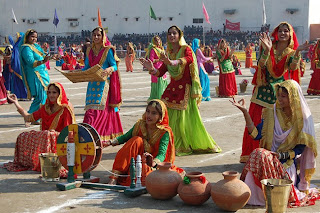Giddha is an evergreen, popular folk dance of
Punjab. It is known from the scriptures that this dance form is derived from an
ancient dance known as ring dance which is very much similar to bhangra. It is stylistically
simple, free-style and spontaneous dance form. This dance has a female dominance. It is a highly creative dance which
reflects feminine beauty.
Women
perform this dance mainly at festive or social occasions.
This dance is performed in circles. All the female
participants gather in a circle. One of the dancers sits in the circle with a
drum. During the performance all the participants move in a circle.
The swinging
and twisting the body, shaking the shoulders while bending knees make this
dance distinguishable from other dance forms. One can identify Giddha when they
see the women clapping their hands during the dance performance.
Clapping is one of the prominent features of this dance form. The movement of
legs is also a feature of this dance form. The dancers enact verses called
bolis, which represent folk poetry at its best. This dance exhibits teasing,
fun and exuberance of Punjabi life. These bolis are based on different emotional
subjects like arguments, humorous, teasing, love, nature and various topics.
This dance can be also theme based i.e some talk about love affairs to the
loneliness of a bride separated from her groom. Two or three women form
a group and perform these acts by coming in the centre of the circle. Mimicry is also very popular in
Giddha. One girl may play the aged bridegroom and another his young bride;
or one may play a quarrel-some sister-in-law and another a humble bride. In
this way Giddha provides for all the best forum for venting of one's emotions.
Giddha dance incorporate village life scenes of woman spinning cotton, fetching
water from the well, grinding, etc. This is accompanied with appropriate boli
and songs.
No
musical instruments are used in this dance. Only drum(dolakh) is used to provides
the rhythm for the dance. The distinctive hand-claps of the dancers are
a prominent feature of this art-form.
All we
know that this dance is colourful so are the clothes. As this is a feminine
dance colourful clothes adds a grace to the beauty of the female dancers. The
dress worn by the females include Dupatta (chunni or scarf),Kameez
(shirt),Salwaar (baggy pants), Tikka (jewellery on the forehead),Jhumka (long
dangling earrings),Paranda (braid tassle),Suggi-Phul (worn on head),Raani-Haar
(a long necklace made of solid gold),Haar-Hamela (gem-studded golden
necklace),Baazu-Band (worn around upper-arm),Pazaibs (anklets).






No comments:
Post a Comment